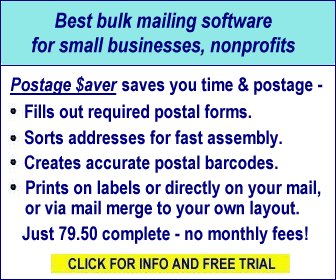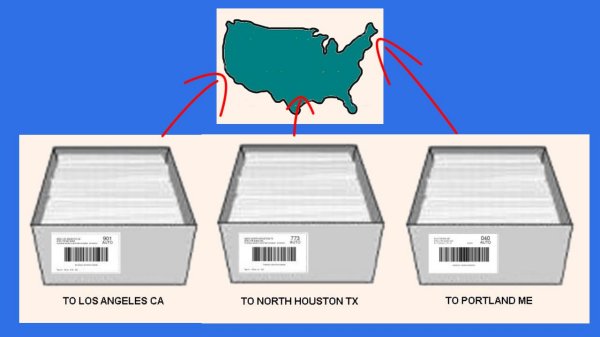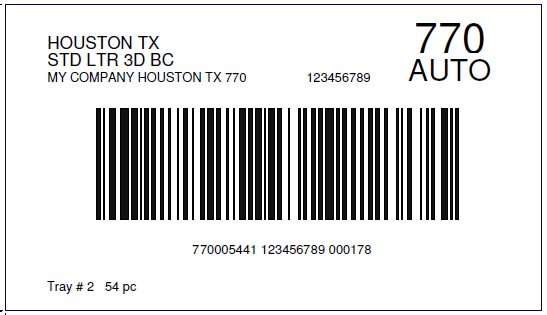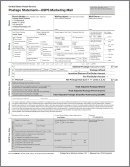Learn About Bulk Mailing and Tracking → Preparing Your Mailing
 Scott
Scott
Postage $aver Software
OK, you have the required mailing permit and a 6 or 9-digit USPS Mailer ID. You've printed your mail pieces and you have your mailing list. Now what?
 To earn bulk mail rates, you must do some of the work that USPS would otherwise do. Fortunately, there is low-cost software that can do much of this for you. This page covers the steps:
To earn bulk mail rates, you must do some of the work that USPS would otherwise do. Fortunately, there is low-cost software that can do much of this for you. This page covers the steps:
 Verifying your mailing list's accuracy.
Verifying your mailing list's accuracy.
 Sorting your list.
Sorting your list.
 Adding USPS Intelligent Mail barcodes.
Adding USPS Intelligent Mail barcodes.
 Assembling the mail into trays or sacks.
Assembling the mail into trays or sacks.
 Completing postal paperwork.
Completing postal paperwork.
BTW, you are never required to prepare mail as bulk mail, no matter how many pieces you have. USPS is perfectly happy for you to put First Class postage on every piece you mail, and they'll take care of the rest.
But if you want to get the best postage rates, you have to meet these requirements.
5 Steps for Preparing Your USPS Bulk Mailing
 Scott
ScottPostage $aver Software
OK, you have the required mailing permit and a 6 or 9-digit USPS Mailer ID. You've printed your mail pieces and you have your mailing list. Now what?
 To earn bulk mail rates, you must do some of the work that USPS would otherwise do. Fortunately, there is low-cost software that can do much of this for you. This page covers the steps:
To earn bulk mail rates, you must do some of the work that USPS would otherwise do. Fortunately, there is low-cost software that can do much of this for you. This page covers the steps:BTW, you are never required to prepare mail as bulk mail, no matter how many pieces you have. USPS is perfectly happy for you to put First Class postage on every piece you mail, and they'll take care of the rest.
But if you want to get the best postage rates, you have to meet these requirements.
What address verification does USPS
require for bulk mailing?
USPS does not want to handle mis-addressed bulk mail because it increases their costs. So they have two different kinds of accuracy checking that you may be required to do for your mailing list:
To start out, check out our Move Update & Cass checklist to figure out whether you need Move Update, CASS certification, both or neither.
If you need to do one or both, we have pages that explain Move Update and CASS certification in detail and include links to vendors that our customers frequently use.
You must do any required address verification before you sort your mailing list and print your addresses, and you must use the new address information provided (not your original list). Otherwise, it will have done you no good to have the list checked and you won't be in compliance for USPS.
And, if the Move Update process tells you that some of your recipients have moved out of your target area, you may want to remove them from your list before you prepare your mailing, depending on the purpose of the mailing. Likewise if some of your addresses fail the CASS certification process, you may want to correct them before mailing.
- Has the recipient moved? ("Move Update" or "NCOA" checking)
- Is the address valid? ("CASS" certification)
To start out, check out our Move Update & Cass checklist to figure out whether you need Move Update, CASS certification, both or neither.
If you need to do one or both, we have pages that explain Move Update and CASS certification in detail and include links to vendors that our customers frequently use.
You must do any required address verification before you sort your mailing list and print your addresses, and you must use the new address information provided (not your original list). Otherwise, it will have done you no good to have the list checked and you won't be in compliance for USPS.
And, if the Move Update process tells you that some of your recipients have moved out of your target area, you may want to remove them from your list before you prepare your mailing, depending on the purpose of the mailing. Likewise if some of your addresses fail the CASS certification process, you may want to correct them before mailing.
How do I sort my mail to meet USPS bulk mail requirements?
To get bulk mail postage discounts, your mail must be sorted and placed into USPS containers (trays or sacks) according to USPS rules. Flat-sized pieces, some parcels, and letter-sized pieces with unusual shapes must also first be rubber-banded together into specific "bundles" before being placed into their containers.
This is NOT simply sorting your mail in zip code order. The sorting requirements are designed to get your mail to its destination with as little handling by USPS as possible, so in most cases you are required to combine various zip codes to fit the USPS sorting and transportation system.
So, for example, if you have at least 150 letter-sized pieces going to the same zip code, USPS requires you put them in their own tray, which then travels directly to the facility where that mail is handled without needing to be sorted anywhere else. (Sometimes, more than one zip code that are handled by the same sorting machine must be combined together to meet the 150-piece minimum. That's called a "5-digit scheme".)
But, if you have just a few letter-sized pieces going to a zip or scheme, but 150 or more that all will be handled by the same sorting center, you'll put those together in a tray that travels directly to the sorting center. The process works its way up through the USPS distribution system, until you're left with just odds and ends in a "mixed" tray.

This gets complicated, since the distribution pattern is different for each mail class, mail size, and barcoded vs. nonbarcoded mail. And the sorting lists and scheme combinations change monthly.
That's why you need USPS-certified presort software. Our Postage $aver software has all the sorting rules built in and is updated regularly to keep your mail going where it should. It sorts your list by tray or sack (and bundle, where required), prints easy-to-follow instructions telling you what zips go into which container, and prints all the postal paperwork and container tags.
Postage $aver is certified for accuracy USPS, so you can avoid any hassles at the post office. And if you do have a problem with USPS, we'll help you solve it. That's why we say that Postage $aver is like having your own in-house postal expert!
This is NOT simply sorting your mail in zip code order. The sorting requirements are designed to get your mail to its destination with as little handling by USPS as possible, so in most cases you are required to combine various zip codes to fit the USPS sorting and transportation system.
So, for example, if you have at least 150 letter-sized pieces going to the same zip code, USPS requires you put them in their own tray, which then travels directly to the facility where that mail is handled without needing to be sorted anywhere else. (Sometimes, more than one zip code that are handled by the same sorting machine must be combined together to meet the 150-piece minimum. That's called a "5-digit scheme".)
But, if you have just a few letter-sized pieces going to a zip or scheme, but 150 or more that all will be handled by the same sorting center, you'll put those together in a tray that travels directly to the sorting center. The process works its way up through the USPS distribution system, until you're left with just odds and ends in a "mixed" tray.

This gets complicated, since the distribution pattern is different for each mail class, mail size, and barcoded vs. nonbarcoded mail. And the sorting lists and scheme combinations change monthly.
That's why you need USPS-certified presort software. Our Postage $aver software has all the sorting rules built in and is updated regularly to keep your mail going where it should. It sorts your list by tray or sack (and bundle, where required), prints easy-to-follow instructions telling you what zips go into which container, and prints all the postal paperwork and container tags.
Postage $aver is certified for accuracy USPS, so you can avoid any hassles at the post office. And if you do have a problem with USPS, we'll help you solve it. That's why we say that Postage $aver is like having your own in-house postal expert!
Do I need to add barcodes to get bulk mail discounts? How do I do that?
Barcodes are used by USPS to automatically sort mail down to each individual mailbox. They can also include information for tracking and address correction. Barcodes are not used for postage payment.
USPS prints barcodes on most mail, and you are not required to do that to get bulk mail rates (except on parcel-sized pieces, which use a different barcode).
But you can earn an additional postage discount by printing barcodes on your bulk mail so that USPS doesn't need to do it. Plus, if you always add barcodes to your bulk mail and submit your paperwork electronically, USPS will waive your $320 Annual Mailing Fee!
Adding barcodes also let you track your mail, since USPS keeps a record each time the barcode is scanned as the mail moves through sorting process.
The barcodes are called "Intelligent Mail" barcodes (IMBs) and look like this:
 While there are benefits for barcoding, there are some small costs to create the barcodes.
While there are benefits for barcoding, there are some small costs to create the barcodes.
First, as explained above, you'll need to CASS-certify your mailing list so that you'll have the zip+4 and "delivery point" code necessary for each barcode. That typically costs only about $2 per thousand addresses. And if you already are having your list checked against the National Change of Address (NCOA) system, your list gets CASS-certified for no extra charge as part of that process.
You'll also need software that creates and prints the barcode for each address. Our Postage $aver Pro software prints addresses with barcodes in sorted order directly onto your mail pieces, or onto address labels with your choice of several popular label formats. Postage $aver can also save the barcodes into your mailing list file so you can print them as part of a mail merge or variable data printing job.
Along with the software, you'll need an Intelligent Mail barcode font to actually print the barcodes. Our SmartBars 12 font is free with Postage $aver Pro and is installed automatically with the software, or you can purchase it separately to use with other barcoding software.
Here's our more detailed look at Intelligent Mail barcoding.
USPS prints barcodes on most mail, and you are not required to do that to get bulk mail rates (except on parcel-sized pieces, which use a different barcode).
But you can earn an additional postage discount by printing barcodes on your bulk mail so that USPS doesn't need to do it. Plus, if you always add barcodes to your bulk mail and submit your paperwork electronically, USPS will waive your $320 Annual Mailing Fee!
Adding barcodes also let you track your mail, since USPS keeps a record each time the barcode is scanned as the mail moves through sorting process.
The barcodes are called "Intelligent Mail" barcodes (IMBs) and look like this:

First, as explained above, you'll need to CASS-certify your mailing list so that you'll have the zip+4 and "delivery point" code necessary for each barcode. That typically costs only about $2 per thousand addresses. And if you already are having your list checked against the National Change of Address (NCOA) system, your list gets CASS-certified for no extra charge as part of that process.
You'll also need software that creates and prints the barcode for each address. Our Postage $aver Pro software prints addresses with barcodes in sorted order directly onto your mail pieces, or onto address labels with your choice of several popular label formats. Postage $aver can also save the barcodes into your mailing list file so you can print them as part of a mail merge or variable data printing job.
Along with the software, you'll need an Intelligent Mail barcode font to actually print the barcodes. Our SmartBars 12 font is free with Postage $aver Pro and is installed automatically with the software, or you can purchase it separately to use with other barcoding software.
Here's our more detailed look at Intelligent Mail barcoding.
How do I assemble my bulk mailing into trays or sacks?
All bulk mail must be mailed in specific USPS mail trays, tubs or sacks. USPS provides these containers free (for postal use only), and you can get pick some up at most any post office and all postal bulk mail centers.
The mail is sorted into the containers as described above. Depending on how your mailing list sorts, you could end up with some full containers, some partially full, and some with as few as one piece (for example, if you have only one local address in the mailing.)
The rules are very specific about what pieces, and how many, go in each container, and not following the rules could cause your mailing to be rejected by USPS, even when the sorting doesn't seem to make sense.
Containers for letter-sized and postcard-sized mail: Letter-sized and postcard-sized mail get placed into trays. There are 3 sizes of trays for letter-sized and postcard-sized mail.

 Type "MM" trays are for mail up to 4 5/8" tall and 10" long, although you can usually use them for pieces up to 5 1/2" tall (half of a normal letter-sized sheet) by letting the pieces lean down a bit in the tray. MM trays come in 1' and 2' lengths.
Type "MM" trays are for mail up to 4 5/8" tall and 10" long, although you can usually use them for pieces up to 5 1/2" tall (half of a normal letter-sized sheet) by letting the pieces lean down a bit in the tray. MM trays come in 1' and 2' lengths.
If the pieces you have for a sorting destination can all fit in a 1' MM tray, you must use a 1' tray instead than a half-empty 2' tray. On the other hand, if there are too many to fit in a 1' tray, you must use a 2' tray, not two 1' trays.
 Type "EMM" trays are for letter-sized and postcard-sized pieces that are too tall or too wide to fit in MM trays. They come only in a 22" length.
Type "EMM" trays are for letter-sized and postcard-sized pieces that are too tall or too wide to fit in MM trays. They come only in a 22" length.
The mail in a tray should all face the same way, with the address side facing the end of the tray that has the holder for the destination tag. Generally, it doesn't matter what order the pieces are in within a tray, though there are some exceptions. (For example, "carrier route" sorted letters must be in the tray in the order that the carrier delivers the mail.)
If your mail fills, or nearly fills, the tray, it should just be stacked into the tray without any rubber bands. If your tray is not full or nearly full, you must rubber-band the pieces as necessary to keep them from flopping around and getting unstacked, but no particular grouping or order is required. Just keep each group to less than six inches thick, so you can hold the bundle in one hand. Size 64 rubber bands usually work pretty well.
(The exception to this rule is for letter-sized mail that is of an unusual shape, so that it is considered to be "nonmachinable". These must be banded together in specific bundles like flat-sized mail, as explained below.)

 Containers for flat-sized mail and parcels: Flat-sized mail gets placed into tubs, also called "flat trays", except for Bound Printed Matter flats, which are placed in sacks. Parcels are prepared in sacks, or are placed directly on pallets if there are enough pieces.
Containers for flat-sized mail and parcels: Flat-sized mail gets placed into tubs, also called "flat trays", except for Bound Printed Matter flats, which are placed in sacks. Parcels are prepared in sacks, or are placed directly on pallets if there are enough pieces.
All flat-sized mail in sacks, and some in tubs, is first rubber-banded into specific "bundles". A bundle is simply a stack of mail, no more than 6" thick", held together by rubber bands. Size 64 rubber bands generally work well. All pieces in the bundle must face the same way.

Labeling containers and bundles: Each tray, tub and sack must be labeled with a tag printed in a very specific format, which includes a special barcode. If you know exactly what tags you need, you can order them from USPS, but generally it's easier and always faster for your bulk mail software to print these. Our Postage $aver software figures out and prints the tags you need for each mailing automatically. Or, if you know what the tag needs to say, our Postal Barcoder Max software lets you create the tags manually.
To mark the destination of each bundle, you have two options. The option USPS prefers (and requires in some cases) is to add a line at the top of the address that signifies the sorting level and destination zip of the bundle. This is called an "Optional Endorsement Line", or "OEL", even though it's not really optional. An OEL looks like "*******3D 780". If you look at most any catalog you get in the mail, you'll see an OEL above the address. Your bulk mail software will create the OEL for each piece.


The second, older option is to put a special colored sticker, available free at USPS bulk mail centers, on the top piece of each bundle. Use this option only if there is no room on your address label for an OEL, or if you do not have software to create the correct OEL. Since these stickers can fall off of your mail, and don't have all the information contained in an OEL, USPS prefers OELs over stickers.
The mail is sorted into the containers as described above. Depending on how your mailing list sorts, you could end up with some full containers, some partially full, and some with as few as one piece (for example, if you have only one local address in the mailing.)
The rules are very specific about what pieces, and how many, go in each container, and not following the rules could cause your mailing to be rejected by USPS, even when the sorting doesn't seem to make sense.
Containers for letter-sized and postcard-sized mail: Letter-sized and postcard-sized mail get placed into trays. There are 3 sizes of trays for letter-sized and postcard-sized mail.


If the pieces you have for a sorting destination can all fit in a 1' MM tray, you must use a 1' tray instead than a half-empty 2' tray. On the other hand, if there are too many to fit in a 1' tray, you must use a 2' tray, not two 1' trays.
 Type "EMM" trays are for letter-sized and postcard-sized pieces that are too tall or too wide to fit in MM trays. They come only in a 22" length.
Type "EMM" trays are for letter-sized and postcard-sized pieces that are too tall or too wide to fit in MM trays. They come only in a 22" length.The mail in a tray should all face the same way, with the address side facing the end of the tray that has the holder for the destination tag. Generally, it doesn't matter what order the pieces are in within a tray, though there are some exceptions. (For example, "carrier route" sorted letters must be in the tray in the order that the carrier delivers the mail.)
If your mail fills, or nearly fills, the tray, it should just be stacked into the tray without any rubber bands. If your tray is not full or nearly full, you must rubber-band the pieces as necessary to keep them from flopping around and getting unstacked, but no particular grouping or order is required. Just keep each group to less than six inches thick, so you can hold the bundle in one hand. Size 64 rubber bands usually work pretty well.
(The exception to this rule is for letter-sized mail that is of an unusual shape, so that it is considered to be "nonmachinable". These must be banded together in specific bundles like flat-sized mail, as explained below.)


All flat-sized mail in sacks, and some in tubs, is first rubber-banded into specific "bundles". A bundle is simply a stack of mail, no more than 6" thick", held together by rubber bands. Size 64 rubber bands generally work well. All pieces in the bundle must face the same way.

Labeling containers and bundles: Each tray, tub and sack must be labeled with a tag printed in a very specific format, which includes a special barcode. If you know exactly what tags you need, you can order them from USPS, but generally it's easier and always faster for your bulk mail software to print these. Our Postage $aver software figures out and prints the tags you need for each mailing automatically. Or, if you know what the tag needs to say, our Postal Barcoder Max software lets you create the tags manually.
To mark the destination of each bundle, you have two options. The option USPS prefers (and requires in some cases) is to add a line at the top of the address that signifies the sorting level and destination zip of the bundle. This is called an "Optional Endorsement Line", or "OEL", even though it's not really optional. An OEL looks like "*******3D 780". If you look at most any catalog you get in the mail, you'll see an OEL above the address. Your bulk mail software will create the OEL for each piece.


What paperwork do I need for USPS bulk mailing?
Postage statement: When you finish preparing your mailing, you'll need to complete a "postage statement" form. The postage statement tells USPS who you are, how many pieces you are mailing, how many trays, sacks or tubs, and what postage you expect to be charged.
Postage $aver prints and fills out this form for you automatically. You can also download blank forms and fill them out yourself:
If your mailing is not full-service, or is full-service but has fewer than 50,000 pieces, the simplest way to electronically submit your postage statement is to use the USPS Postal Wizard, a web form where you can enter the information from your postage statement.
If you use our Postage $aver Pro or Postage $aver Lite software to prepare your mailing, you'll automatically get line-by-line instructions telling you exactly what to enter into the Postal Wizard. Otherwise, here's our step-by-step Postal Wizard walkthrough.
For full-service barcoded mailings of 50,000 pieces or more, you must submit a special "Mail.dat" or "Mail.xml" file that includes piece-level barcodes. The software to do this expensive and is not usually cost-effective for small volume mailers.
Price Qualification and Container/Bundle reports: You may also be asked for a price qualification report, which is a list of the contents of each tray, tub or sack, and the rate categories for each. Postage $aver produces this report. While it is not absolutely required for every mailing, it's makes life a lot easier for the postal clerk who has to review your mailing, and you always want to make your postal clerk's life as easy as you can.
Periodicals Class mailers must also provide lists of containers and bundles, since Periodical Class mailers pay a charge for each outside-county container and bundle submitted.
CASS Summary report: If you're barcoding your mail, you may also be asked for a CASS Summary report, (aka "Form 3553"). This form shows that your mailing list has been CASS certified, as required for barcoding. Form 3553 comes from the company or software that did the CASS certification. It's a good idea to bring a copy with you when you take your mailing to USPS. They don't always ask for it, but if they do and you don't have it, your mailing may be delayed until you provide it.
Ready to start saving postage right now?
Try Postage $aver FREE for 30 days!
Click for complete info and free trial!

 Form 3602-R - Marketing Mail Commercial
Form 3602-R - Marketing Mail CommercialForm 3602-N - Marketing Mail Nonprofit
Form 3600-FCM - First Class Mail (presorted, non-presorted), USPS Ground Advantage
Form 3541 - Periodicals Class
Form 3605 - Bound Printed Matter, Parcel Select
If your mailing is not full-service, or is full-service but has fewer than 50,000 pieces, the simplest way to electronically submit your postage statement is to use the USPS Postal Wizard, a web form where you can enter the information from your postage statement.
If you use our Postage $aver Pro or Postage $aver Lite software to prepare your mailing, you'll automatically get line-by-line instructions telling you exactly what to enter into the Postal Wizard. Otherwise, here's our step-by-step Postal Wizard walkthrough.
For full-service barcoded mailings of 50,000 pieces or more, you must submit a special "Mail.dat" or "Mail.xml" file that includes piece-level barcodes. The software to do this expensive and is not usually cost-effective for small volume mailers.
Price Qualification and Container/Bundle reports: You may also be asked for a price qualification report, which is a list of the contents of each tray, tub or sack, and the rate categories for each. Postage $aver produces this report. While it is not absolutely required for every mailing, it's makes life a lot easier for the postal clerk who has to review your mailing, and you always want to make your postal clerk's life as easy as you can.
Periodicals Class mailers must also provide lists of containers and bundles, since Periodical Class mailers pay a charge for each outside-county container and bundle submitted.
CASS Summary report: If you're barcoding your mail, you may also be asked for a CASS Summary report, (aka "Form 3553"). This form shows that your mailing list has been CASS certified, as required for barcoding. Form 3553 comes from the company or software that did the CASS certification. It's a good idea to bring a copy with you when you take your mailing to USPS. They don't always ask for it, but if they do and you don't have it, your mailing may be delayed until you provide it.
Ready to start saving postage right now?
Try Postage $aver FREE for 30 days!
Click for complete info and free trial!












